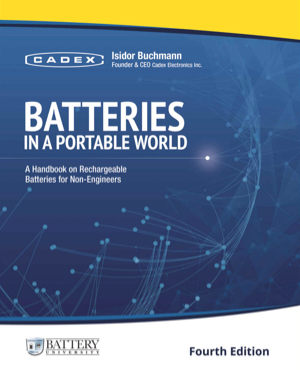Remote control (RC) enthusiasts are experimenting with all imaginable methods to maximize battery performance. The electric motor of a model race car draws 30A for about 4 minutes delivered by a 7.2V battery. This is over 200W of power, a large amount for a small battery. NiCd batteries often energize these devices, and a technique that seems to enhance the power is zapping NiCd cells with a very high pulse current. This is said to increase the cell voltage slightly and generate more power.
According to experts, zapping works best with standard NiCd cells. NiMHs have been tried but they do not produce consistent results. Nor can zapping be applied to Li-ion. Companies specializing in zapping use a very high quality NiCd cell from Japan, and the sub-C is the most popular size. The factory handpicks the cells, and they come with a unique label in a fully discharged state. When measuring the empty cell, the open circuit voltage should read between 1.11 and 1.12V. If the voltage is lower than 1.06V, then the cell is suspect and zapping does not enhance the performance.
To zap a NiCd battery, charge a 47,000µF capacitor to 90V and apply the raw power directly across a single NiCd cell of 1.2V. After the shock treatment, cycle the cell and zap it once more. Experts say that once a cell is treated and used in service, further zapping will no longer improve performance, nor will it regenerate a weak cell.
The voltage increase on a successfully zapped battery is between 20 and 40mV when loaded with 30A. According to experts, the voltage gain is permanent, but there is a small drop of the gained voltage with usage and time.
There are no apparent side effects from zapping, however, battery manufacturers remain silent about this treatment. No scientific explanations are available as to why zapping improves battery performance other than the gained voltage and the apparent lower internal resistance. There is little information available regarding the longevity of the cells after the treatment.
Another method to improve NiCd batteries is through a recondition program. Tests performed at the Cadex laboratories reveal a permanent capacity gain of about 7 percent when servicing new NiCd with recondition, a program that lowers the battery voltage to 0.4V/cell on a secondary discharge(See BU-807: How to Restore Nickel-based Batteries) This capacity gain is not fully understood other than to assume that the battery improves through additional formatting. Another explanation is the removal of early memory. Since new batteries are stored with some charge, the self-discharge that occurs during storage may contribute to the buildup of crystalline formation, which recondition reverses.
The interest for RC enthusiasts is shifting to high-performance Li-ion. The question is asked: “Does Li-ion perform as well as NiCd?” Some experts say no, even when choosing the highest-performing Li-ion. NiCd remains the most rugged rechargeable battery; it is also the only battery that can be ultra-fast charged with minimal stress. When the German car manufacturers switched from NiCd to Li-ion for their high precision power tools, the battery specifications needed to be relaxed because Li-ion could not meet the NiCd requirements.

Comments
Looking for comments from the previous website?
Comments from the previous website are not compatible with our new commenting system but we have preserved them so our users can still reference and make use the information in them.

Yeah, but which way round do you connect the zapper? + to + asa aif you were charging them or + to - to make a complete circuit?